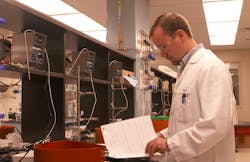Equipment Monitoring System Saves Fujirebio 1100 Hours of Work
Fujirebio Diagnostics Inc. produces a blood test device used to detect biomarkers in cancerous tumors. Since the company produces medical devices, its operations are governed by the FDA and other worldwide agencies. A typical year sees the company’s production operations inspected 12 times. The regulatory requirement to maintaining detailed records of the company’s equipment in operation—most notably the refrigerated equipment that stores the blood tests’ cells in subzero temperatures—led the company to investigate replacing its paper-based GMP (Good Manufacturing Practice) records system.
As a first step in replacing its paper-based processes with an electronic equipment management system, the company decided to track equipment temperature readings.
“We wanted to allow personnel to monitor equipment temperatures from their workstations,” says Ken Kovacs, preventative maintenance and tech advisor, at Fujirebio’s Malvern, Pa., location. Kovacs notes that the idea behind these initial reports was to “generate a review by exception and incorporate use of electronic signature for approval of reports.”
Initially, Fujirebio considered using a dedicated equipment monitoring system. While that system could do the job needed by Fujirebio, that’s all it could do. So the company also looked at a PLC/HMI/MOM server-based solution. This option was 50 percent more expensive than the dedicated equipment monitoring system, but the possibilities for expanding use of the system were so much greater that the company decided to go with the PLC/HMI/MOM system.
After interviewing different system integrators about the project, Fujirebio decided on the Invensys' Wonderware System Platform with InTouch HMI, Historian and Workflow. Fujirebio installed sensors and Allen-Bradley Point I/O panels to connect the Invensys equipment to an Allen-Bradley ControlLogix PLC.
The initial screen view in the Invensys equipment monitoring system, Kovacs says, is a department overview list that displays the equipment being tracked, as well as the health of the PLC and sensors. From this screen, users can click on equipment information and see current temperatures or drill down into equipment details. “The data can even be viewed via a floorplan, which shows equipment as it’s located in the facility,” he says.
Based on the data gathered by the system, two reports are generated—an Event Form and Department Summary Report Form. Kovacs says that Event Form is used for equipment monitoring and system alarms. The Department Summary is used to approve a monthly summary of events at department and QA level.
“The Department Summary Form replaces the manually generated equipment temperature log and chart recorder graphs,” Kovacs says. “QA has final approval of this report.” Shown on this report are equipment information, alarms, name of reviewer/approver and comments.
With the new system, we can see detailed “equipment cycling for better analysis of equipment operations,” Kovacs says. “Log reports on the equipment give us a very good look at what occurs all during the day. We can see when defrosting occurs just by looking at the data and even when the doors were opened. Which means we can also more easily determine when equipment is not operating properly.”
According to Kovacs, excursions, i.e., equipment deviations and alarms, are down 50 percent since installing the new system because early warnings from the system notify users when equipment is going out of spec before it becomes a problem.
The old paper reports that the electronic Department Summary Form replaced were several inches think and had to be reviewed completely by hand and archived because they are auditable by the FDA, just as the electronic Department Summary Form is.
“Everyone loves not having to go through those paper records anymore,” Kovacs says. “They used to spend a lot of time looking through all the good data just to find one excursion.” He adds that the new electronic reports have eliminated 1,100 hours a year spent on combing through paper reports for specific data points.
Based on the success of the first equipment monitoring phase, Fujirebio is now looking at future expansion capabilities such as batch data management, track and trace/genealogy, weigh scale automation, statistical process control, clean room monitoring, bioreactor monitoring, bar code applications and monitoring and control of process equipment. The potential to extend the system for such additional applications is what drove the company’s willingness to spend 50 percent more on the PLC/HMI/MOM system versus a dedicated equipment monitoring system.
Despite having just gone live with this system in July 2013, the results have been so impressive that Fujirebio’s CEO is interested in rolling the system out globally, Kovacs says.
The video below provides and overview of Fujirebio's equipment monitoring system.
About the Author
David Greenfield, editor in chief
Editor in Chief

Leaders relevant to this article:
